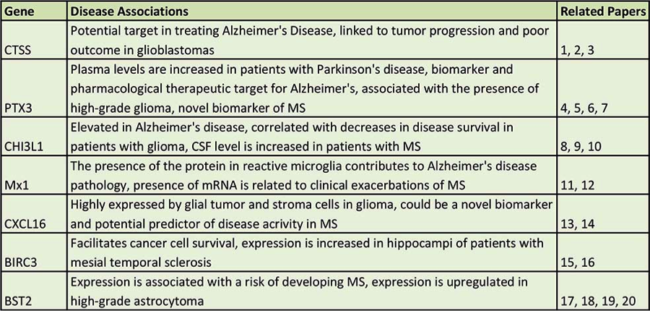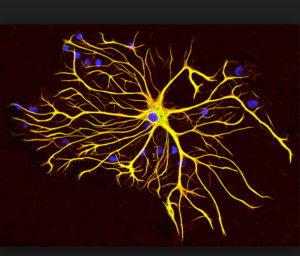Chinese investigators from Nanjing Medical University report that HHV-6A infection of astrocytes is associated with changes in the cell’s gene expression that are also found in several CNS diseases including Alzheimer’s, glioma, and multiple sclerosis. Within 24 of infection, gene expression patterns and cell signaling changed significantly.
The investigators cultured human astrocyte cells and subsequently infected them with HHV-6A virus. The mRNA was then isolated and sequenced in order to detect and quantify gene activity in infected cells and compare the activity to that of uninfected cells. The investigators used gene ontology analysis to determine the biological processes, cellular components, and molecular functions of the differentially expressed genes and signalling pathways.
39 genes had significant differential expression and were shown to be associated with antiviral functions as well as several CNS diseases previously associated with possible HHV-6 reactivation: Alzheimer’s Disease, glioma, mesial temporal lobe sclerosis, and multiple sclerosis. Of the 39, 7 were associated with more than two CNS diseases. Quantitative PCR confirmed the upregulation of these genes in the infected cells, and western blot assays were also run to confirm protein expression for some of the genes.

Cellular genes expressed during HHV-6A infection of astrocytes.
The 7 upregulated genes that were associated with more than two CNS conditions were CTSS, PTX3, CHI3L1, Mx1, CXCL16, BIRC3, and BST2. Elevated levels of some of the associated proteins of each gene serve as biomarkers for the development or progression of neurological disease, while other proteins have known pathogenic roles in the development of a neurologic condition. For example, cathepsin S or CTSS is a potential target in treating Alzheimer’s (Schechter 2011), and it is also linked to tumor progression and poor outcome in glioblastomas (Flannery 2006). It plays a role in inhibiting autophagy and apoptosis in glioblastoma cells (Zhang 2014). In the case of BST2, its expression is associated with a risk of developing MS (Nexø 2013), and expression is upregulated in high-grade astrocytoma (Wainwright 2011).
A 2011 study linked HHV-6A infection in astrocytes to activation of caspase-3, -8, and -9, as well as Bax up-regulation, NF-kB down-regulation, and Bcl-2 down-regulation, while another study found high levels of IL-6, IL-8, and TGF-β in HHV-6A infected astrocytes and fluid samples from glioma cysts with HHV-6A (Gu 2011) (Chi 2012). Early increases in mRNA and protein expression of the glial glutamate transporter EAAT-2 followed by a sustained decrease in mRNA expression have also been found in HHV-6A infected astrocytes (Fotheringham 2008).
Previously, HHV-6 has been found in 23% of peripheral blood leukocyte samples in patients with Alzheimer’s Disease compared to 4% from controls (Carbone 2014). Moreover, HHV-6 has been implicated in cases of glioma (Crawford 2009)(Chi 2012) and has also been found in 48% of Reed-Sternberg cells of nodular sclerosis Hodgkin lymphoma cases (Siddon 2012). HHV-6A/B have shown an association with MS in a number of studies as well.
The authors hope that identifying differentially expressed genes in the HHV-6A infected human astrocyte will strengthen our understanding of the possible pathogenic mechanisms of HHV-6A in the brain.
For more information, read the paper: Shao 2016.
Table References:
| 1 | Flannery 2006 |
| 2 | Schechter 2011 |
| 3 | Zhang 2014 |
| 4 | Lee 2011 |
| 5 | Locatelli 2013 |
| 6 | Osera 2012 |
| 7 | Ummenthum 2016 |
| 8 | Antonell 2014 |
| 9 | Bonneh-Barkay 2010 |
| 10 | Kazakova 2014 |
| 11 | Van der Voort 2010 |
| 12 | Yamada 1994 |
| 13 | Hattermann 2013 |
| 14 | Holmøy 2013 |
| 15 | Dericioglu 2013 |
| 16 | Yang 2014 |
| 17 | Evans 2010 |
| 18 | Nexø 2013 |
| 19 | Viswanathan 2011 |
| 20 | Wainwright 2011 |

